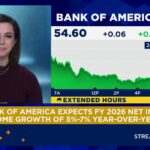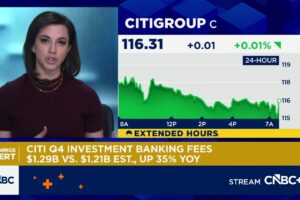A modest amount of money can go a long way when it’s put to work in highly innovative, game-changing businesses.
For the last 18 months, the bulls have been running wild on Wall Street. Following the 2022 bear market, the ageless Dow Jones Industrial Average, widely followed S&P 500, and innovation-powered Nasdaq Composite have all catapulted to fresh record-closing highs.
While some investors are likely waiting for a stock market correction or meaningful pullback before putting their cash to work, it’s important to recognize that time has, eventually, wiped away every notable downturn in Wall Street’s three major stock indexes. If you’re an investor with a long-term mindset, any time can represent the ideal moment to put your money to work.

Image source: Getty Images.
Best of all, most online brokerages have eliminated the variables that had previously kept retail investors from participating on Wall Street. With most commission fees and minimum deposit requirements now shelved, any amount of money — even $300 — can be the perfect amount to invest.
If you have $300 that’s ready to be put to work on Wall Street, and you’re absolutely certain this isn’t cash you’re going to need to pay bills or cover an emergency (should one arise), the following three stocks stand out as no-brainer buys right now for the second half of 2024, if not well beyond.
Visa
The first phenomenal business that rises above the pack and would make for a fantastic buy with $300 for the second half of 2024 is leading payment processor Visa (V 1.90%).
About the only negative that can be said of Visa is that it’s a cyclical business. Companies that are cyclical ebb and flow with the health of the U.S. and global economy. If select predictive indicators prove accurate — for example, if the first decline in U.S. M2 money supply since the Great Depression does signal a coming recession — it’s not out of the equation that consumer and enterprise spending could weaken in the coming quarters.
However, the economic cycle isn’t linear. Whereas three-quarters of all U.S. recessions since the end of World War II were resolved in less than a year, the typical period of growth for the U.S. economy has lasted multiple years. Betting on the U.S. economy to grow over time has been a smart move, and Visa is a company primed to benefit from lengthy expansions.
Visa has a commanding lead in credit card network purchase volume market share in the U.S. (the largest market for consumption globally). But more importantly, it has a decades-long runway to expand its infrastructure into chronically underbanked emerging markets. It has the operating cash flow and balance sheet to do this organically, or it can make the occasional acquisition to rapidly improve its reach, as it did in 2016 with the purchase of Visa Europe.
Furthermore, Visa’s management team has avoided riskier revenue channels that could sink its profit margin of more than 50%. While some of its payment-processing peers also lend, Visa’s management team has focused solely on payment facilitation. This purposeful avoidance of lending ensures that Visa doesn’t have to set aside capital during recessions to cover potential loan losses and credit delinquencies.
The cherry on the sundae for investors is that Visa’s stock is cheaper, relative to forward earnings, than it’s been in quite some time. The company’s forward price-to-earnings (P/E) ratio of 23 marks a 19% discount to its average forward P/E multiple over the last five years.

Image source: Getty Images.
GSK
A second no-brainer stock that’s begging to be bought right now for the second half of 2024 with $300 is none other than pharmaceutical titan GSK (GSK -0.44%), the company formerly known as GlaxoSmithKline.
The biggest headwind GSK is currently contending with is litigation. The company is facing roughly 75,000 court cases that allege its now-discontinued heartburn drug Zantac causes cancer. Various analysts estimate that resolving these cases could lead to a settlement ranging from $1 billion to perhaps north of $3 billion for GSK. Wall Street isn’t a fan of uncertainty, and there’s no timetable for when this litigation will be resolved.
While litigation overhang is never ideal, it’s vital to recognize that GSK can deal with whatever is thrown its way. The company closed out March with nearly 4.1 billion pounds in cash, cash equivalents, and equity investments, which works out to almost $5.2 billion U.S. Furthermore, GSK generated $1.42 billion in cash from operations in the first quarter alone. It has the balance sheet and cash generation to cover a Zantac settlement, should one be reached.
What’s far more important is that GSK’s drug portfolio is firing on all cylinders. Excluding currency changes, GSK’s Vaccines segment delivered 16% sales growth in the first quarter, with Specialty Medicines producing an even more robust revenue growth rate of 17%. All of the company’s core drug segments, including shingles, HIV, respiratory, and oncology, produced double- or triple-digit year-over-year sales growth.
Improved use cases for its therapies, along with strong pricing power and an expansive pipeline, should allow GSK to grow its earnings per share annually by 10% (or more) for the foreseeable future. This makes its stock quite the value at just 8 times forward-year earnings.
The last thing to note about healthcare stocks like GSK is that they’re highly defensive and recession-resistant. Since we don’t get to choose when we become ill or what ailment(s) we develop, demand for GSK’s products should remain constant in pretty much any economic climate.
PayPal Holdings
The third no-brainer stock that can be bought confidently with $300 right now for the second half of 2024 is leading financial technology (“fintech“) company PayPal Holdings (PYPL 2.01%).
PayPal’s fall from grace has been nothing short of brutal. Since peaking in 2021, shares of PayPal have plunged by roughly 80%. This decline can be attributed to post-COVID-19 investment euphoria waning, as well as competition increasing in the digital payment arena. PayPal’s once-lofty growth rate has slowed decisively.
Yet in spite of these challenges, many of PayPal’s key performance indicators signal that it’s headed in the right direction. For instance, total payment volume (TPV) traversing its networks (primarily PayPal and Venmo) continues to grow by a double-digit percentage, excluding currency movements. During the first quarter, payment transactions grew 11% to 6.5 billion from the previous year, with TPV increasing 14% on a constant-currency basis to $403.9 billion. We’re still in the very early innings of digital payment adoption.
What’s more, the company’s active accounts are becoming more engaged with each passing year. When 2020 came to a close, the company’s active accounts had completed an average of 40.9 payments over the trailing 12-month (TTM) period. But as of the March-ended quarter of 2024, active accounts averaged 60 payments on the nose over the TTM. Even if new account growth remains tepid, higher engagement from existing accounts can meaningfully increase the company’s gross profit.
Another upside catalyst for PayPal’s stock is relatively new CEO Alex Chriss, who came over from Intuit‘s Small Business segment. Chriss has a keen eye for cutting costs, and understands how new sales channels can transform PayPal’s bottom line. As an example, the company announced in late May that it’ll be rolling out an advertising platform, which should benefit from lengthy periods of economic expansion.
The last puzzle piece for PayPal is the company’s historically inexpensive valuation. Its forward P/E ratio of 12 represents a 44% discount to its trailing five-year forward-earnings multiple.











